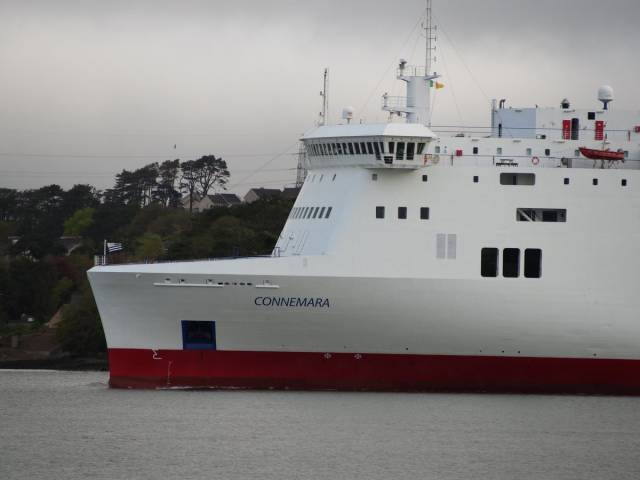#FerryNews - Europe Day aptly coincided with Brittany Ferries albeit delayed start of the first ever direct Ireland-Spain ferry service when Connemara departed Cork at lunchhour today bound for Santander, writes Jehan Ashmore.
Almost berthed adjacently to Ringaskiddy Ferry Terminal where ropax Connemara welcomed passengers and loaded vehicles for today's historic maiden voyage to Spain, was docked Portuguese flagged cruiseship Astoria. The veteran vessel had arrived earlier this morning.
As for the ferry, Connemara had also arrived this morning from France (see below) before launching the new historic continental route directly connecting Ireland and Spain for the first time. A scheduled departure at 11.00 did not take place however the ropax finally was underway two hours later. Connemara then past Roches Point Lighthouse at the mouth of Cork Harbour and out into the open sea.
Connemara, formerly Asterion is on a two-year charter to Brittany Ferries which are to operate the 2007 Italian built Cypriot flagged ropax across the Bay of Biscay service on a trial basis. The 500 passenger /120 cabin ferry is modelled on a économie 'no-frills' service that is scheduled to run two return sailings weekly between Cork and northern Spain.
Crossing times on the 27,000 gross tonnage Connemara connecting Cork and the Cantrabrian port is around 26 hours. Facilites available of the no-frills operated ferry include a self-service restaurant, café/bar, small shop / boutique and seating lounge. In addition to en-suite cabins for passengers that are exclusively motorist-based. The ropax can handle a mix of around 100-freight trailers units and between 80 and 100 tourist vehicles.
Traveling direct to Spain now offers exciting benefits for Irish tourists to explore the lesser known regions of northern Spain compared to air-dependent destinations to the countries Costa's lining the Meditteranean. It is from these well-trodden resorts where around 2 million Irish holiday-makers annually visit the coast but rarely travel to the interior. Now there's northern Spain, where Santander itself is a culinary destination, Bilbao beckons (for Leinster rugby fans on board) as does the Basque Country and regions heading west to Galicia neighbouring Portugal.
The new Irish-continental link will further forge in strengthening travel and cultural ties with Spain but throughout the Iberian peninsula. In addition to assisting existing and developing new freight trade opportunities.
According to the Port of Cork, which has been trying to open an Ireland-Spain link since 2004, the service will remove 1,200kms off road journey distances for many hauliers currently opting for a land-bridge via the UK. The new Spanish service is a also a game-changer given a post-Brexit UK and its relationship between Ireland and with the rest of the EU.
Prior to today's historic maiden voyage on the Ireland-Spain route, Connemara's debut for Brittany Ferries was completed following a sailing to France yesterday. This morning, Connemara returned to Ringaskiddy to complete the round trip. Due to operational reasons, the 186m Connemara docked in Brest rather than the routine port of call at Roscoff.
The Ireland-France route which this year celebrates a 40th anniversary, is served by flagship cruiseferry Pont-Aven at the weekends. Introduction also of Connemara during the week boosts capacity and likewise of the Spanish service is based on an économie no-frills service, except foot-passengers are catered for on the 14 hour Iink to Roscoff.































































